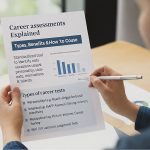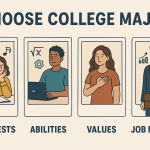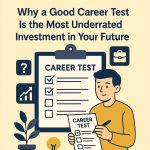Career News
What Can a Personality Test Reveal About Your Career Path?

Introduction: Linking Personality Traits to Professional Success
Why do some people thrive in high-pressure sales while others find fulfillment in meticulous research? The difference often comes down to personality traits the relatively stable patterns of thinking, feeling, and behaving that shape how you engage with the world of work. A well-constructed personality test brings those traits to the surface, translating self-awareness into career clarity.
In this guide you’ll learn:
- How modern personality assessments work and the science behind them.
- Which personality traits influence career satisfaction, performance, and resilience.
- Real-world examples of industries and roles aligned to specific trait profiles.
- A step-by-step roadmap for using your test results to design (or redesign) a fulfilling career path.
Whether you’re a student choosing a major, a mid-career professional eyeing a pivot, or a manager coaching direct reports, understanding personality traits can prevent costly missteps and accelerate measurable success.
- The Science Behind Personality Testing
1.1 Trait Theory 101
Most validated assessments derive from trait theory, particularly the Big Five/OCEAN model:
| Trait | Kernel Question | Work-Life Impact |
| Openness | “How curious and imaginative am I?” | Predicts creativity, change agility, and strategic vision. |
| Conscientiousness | “How organized and dependable am I?” | Correlates strongly with job performance and ethical behavior. |
| Extraversion | “Do I gain energy from social interaction?” | Influences sales success, leadership visibility, and networking. |
| Agreeableness | “How cooperative and empathetic am I?” | Affects team cohesion, customer satisfaction, and conflict style. |
| Neuroticism (Emotional Stability) | “How well do I manage stress and setbacks?” | Shapes resilience, risk tolerance, and crisis performance. |
Reliable assessments show test–retest stability, internal consistency (Cronbach’s α > .70), and criterion validity predicting real-life outcomes such as sales quota attainment or engineering defect rates.
1.2 Beyond Big Five: Motives and Preferences
Tools like the MAPP, DISC, and CliftonStrengths delve into motivation, behavior, and energy zones. They complement trait scores by revealing why you act a certain way and which environments amplify your strengths. The synergy of personality traits plus motivational data offers a 360-degree view of career fit.
- What a Personality Test Uncovers About Your Career Path
2.1 Ideal Role Archetypes
High Openness plus moderate Extraversion? Think product innovation, UX design, or ad-tech strategy. Elevated Conscientiousness with low Neuroticism? Audit, compliance, or medical laboratory science may suit you. By mapping personality traits to occupational archetypes, a test trims months of trial-and-error job hopping.
2.2 Work-Environment Fit
Your personality profile also flags environmental factors pace, structure, autonomy that sustain long-term engagement. Introverted analysts flourish in quiet, data-driven cultures; high-Extraversion recruiters need constant social interaction. Recognizing environmental compatibility prevents burnout and sudden resignations.
2.3 Preferred Collaboration & Leadership Styles
Dominance in DISC predicts directive leadership, while Steadiness suggests coaching-oriented management. These insights allow you to communicate your leadership philosophy during interviews and assess whether a company’s management culture meshes with your personality traits.
2.4 Hidden Derailers and Development Lines
Some traits pose double-edged swords: high Openness can breed endless ideation without execution; sky-high Dominance may intimidate peers. Modern tests often include “dark-side” derailers, letting you craft a personal development plan before stakeholders feel negative effects.
- Industry Snapshots: When Personality Traits Align with Professions
| Industry / Role | Trait Profile That Excels | Why Alignment Works |
| Enterprise Sales | High Extraversion, Medium Conscientiousness, Low Neuroticism | Energized by social interaction, disciplined to follow pipeline processes, resilient to rejection. |
| Software Engineering | High Conscientiousness, Medium Openness, Introversion | Detail-oriented coding, innovative problem-solving, comfortable with solo deep work. |
| Clinical Counseling | High Agreeableness, High Emotional Stability, Medium Openness | Empathy for clients, steady under emotional strain, open to therapeutic models. |
| Entrepreneurship | Very High Openness & Dominance, Moderate Risk Tolerance (low Neuroticism) | Vision-casting, decisive action, ability to weather volatility. |
| Data Science R&D | High Openness and Conscientiousness; lower Extraversion | Curiosity fuels hypotheses; structure ensures reproducible experiments; less need for constant socialization. |
These mappings aren’t absolutes but reveal how personality traits interact with daily task demands and cultural norms.
- Five-Step Roadmap: From Test Results to Career Strategy
Step 1 Choose a Validated Assessment
Prioritize instruments with peer-reviewed data, clear reliability metrics, and transparent job-match algorithms. Avoid pop-culture quizzes lacking scientific backing.
Step 2 Decode Your Report
Block uninterrupted time to read the narrative. Highlight three “Aha” moments strengths you recognize and three “Hmm” moments areas that surprise or challenge you.
Step 3 Map Traits to Current Job Tasks
Create a two-column table: Column A lists your core personality traits; Column B lists weekly responsibilities. Mark high alignment (energizing) versus low alignment (draining). Patterns emerge quickly.
Step 4 Draft Experiments
Micro-shift example: If you score high on Openness but work in a static role, negotiate a weekly “innovation sprint.” Macro-shift example: High Conscientiousness/Introversion stuck in chaotic customer support may warrant a departmental transfer to QA.
Step 5 Review and Iterate Quarterly
Traits are stable; behaviors evolve. Schedule a 90-day reflection to assess whether new tasks increase engagement and to recalibrate goals accordingly.
- Employer Perspective: How Businesses Use Personality Data
- Talent Acquisition Pre-hire screeners identify culture adds, not just fit, reducing early attrition.
- Team Composition Diversity of personality traits improves creativity but needs awareness training to avoid conflict.
- Leadership Development Derailer data informs executive coaching sessions, saving costly leadership missteps.
- Succession Planning Organizations benchmark high performers’ trait profiles to predict next-gen talent pipelines.
Ethical firms treat personality data as one datapoint among many, ensuring assessments don’t reinforce bias.
- Common Questions About Personality Tests and Career Paths
Are test results permanent?
Core traits are consistent, but skill development and maturity can modulate behaviors tied to those traits.
Can two people with similar traits choose different careers?
Absolutely context, values, and skills matter. Personality tests guide; they don’t dictate.
Do employers reject candidates based solely on personality?
Reputable organizations use multi-modal selection: skills assessments, structured interviews, and reference checks alongside personality insights and relevant experience.
- Pitfalls to Avoid
- Over-identification Avoid defining yourself solely by a four-letter type or DISC quadrant.
- Ignoring environment A perfect trait-role match can still fail in a toxic culture.
- DIY interpretation For high-stakes moves, consult a certified coach or psychologist.
Conclusion: Personality Traits Your Career’s Hidden GPS
A validated personality test converts intangible tendencies into concrete career intelligence. By clarifying your personality traits, you gain a personal GPS: steering you toward roles that energize, teams that fit, and environments where your strengths compound. Align that self-knowledge with intentional planning, and you’ll replace career uncertainty with data-backed confidence—no fortune cookie required.





